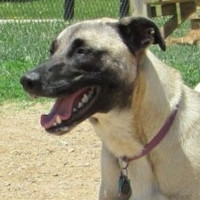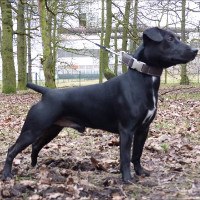 |
Patterdale Shepherd |
|
He is not recognized by the F.C.I. |
Origin |
Great Britain <> Germany -> U.S.A. | |
Translation |
Francis Vandersteen |
A brief presentation of the Patterdale Shepherd |
| The Patterdale Shepherd is a specific cross between the purebred Patterdale Terrier and the purebred German Shepherd. While the German Shepherd parent is well known in the United States, the Patterdale Terrier is not, and the resulting hybrid is rare. Currently, only the Dog Registry of America recognizes the Patterdale Shepherd as a designer hybrid. What's more, some confusion may arise as to the lineage of the Patterdale Terrier's parents, as this name is the historical name given to the Lakeland Terrier, which is larger and weighs more than the modern Patterdale Terrier. |
History of the Patterdale Shepherd |
| Little is known about the Patterdale Shepherd, mainly due to the rarity of the parent Patterdale Terrier breed in the United States. Owners of Patterdale Shepherds, or those wishing to learn more about the hybrid before adoption, should examine the histories of both parents and be sure of the bloodlines they are adopting, as the Patterdale may also refer to other Terrier breeds. |
A little of the Patterdale Terrier |
||
| The Patterdale Terrier is a land dog developed in northern England from the Fell Terrier. The modern-day Lakeland Terrier used to be called the Patterdale Terrier, but has since abandoned the historic name. Patterdales, Lakelands, Fells and Cumberland Terriers share similar bloodlines, but can vary considerably in appearance. The modern-day Patterdale Terrier is a small dog with a smooth or rough outer coat and a short, dense undercoat. The Patterdale Terrier's primary role is that of vermin hunter, and this dog is a tenacious Terrier. Although Patterdale Terriers exist in the United States, the American Kennel Club does not recognize the breed. However, the United Kennel Club recognized the Patterdale in 1995 and provides breed standards. | ||
 |
||
| Presentation of the Patterdale Terrier | ||
A little of the German Shepherd |
||
| The German Shepherd is an extremely popular dog today. As its name suggests, the German Shepherd was first developed in Germany, but only at the turn of the 20th century. Captain Max von Stephanitz wanted a superior breed for breeding and bought the wolf-like German Shepherd in 1899. However, industrialization marginalized agriculture in Germany and Stephanitz succeeded in convincing the German government to use the German Shepherd for police and military work. The German Shepherd excelled in guarding and protection, and played an important role for the Red Cross during the First World War. The German Shepherd was already in the USA when the First World War broke out, but the breed's popularity didn't take off until after the war. The popularity may be due in part to the number of German Shepherds brought home by Allied forces, and in particular to a German Shepherd rescued in France by an American corporal. The American corporal brought the young German Shepherd home to Los Angelos, where the dog starred in numerous feature films as the famous Rin Tin Tin. The American Kennel Club first recognized the German Shepherd Dog in 1908, but changed the name to Alsatian Wolfhound during the First World War. The original name of German Shepherd Dog was restored in 1931, but the British Kennel Club did not restore the original name until 1977. | ||
 |
||
| Standard of the German Shepherd |
Appearance of the Patterdale Shepherd |
| Patterdale Shepherds vary in appearance depending on which parent breed the hybrid most closely resembles. The hybrid is not as tall as the German Shepherd and is muscular. The Patterdale Shepherd's head is proportional to the body and round, with medium-sized ears and large, dark eyes. The Patterdale's muzzle is long and slender, with black-lined lips and a scissor bite. The Patterdale Shepherd's legs are straight and lean, and the tail is long with a moderate brush and can curve slightly over the back. The Patterdale Shepherd's coat is dense, rough and short, and varies in many shades, but often has dark spots on the face, ears and tail. |
Temperament of the Patterdale Shepherd |
| The Patterdale Shepherd is a large dog that needs a strong owner who treats it as an equal. The hybrid is an excellent protector and family dog if it has a healthy, supportive home, and the Patterdale Shepherd is very protective of children. Harsh, negative reinforcement training doesn't work well for the Patterdale Shepherd and can lead to behavioral problems, including separation anxiety, shyness or even aggression. With proper socialization and a healthy lifestyle, the Patterdale Shepherd gets along well with other dogs and even cats. They are moderately friendly to strangers and can be trained as guard dogs. However, they become familiar with new people once threats are properly assessed. Patterdale Shepherds have a lot of energy, and although they are easy to train, they need plenty of physical and mental stimulation to lead a healthy life. |
Needs and activities of the Patterdale Shepherd |
| The Patterdale Shepherd has a lot of energy and is a big dog that needs daily outdoor exercise. Frequent runs in the backyard, walks around the block and visits to the dog park are a must for the Patterdale Shepherd. Despite its size and activity requirements, the Patterdale Shepherd can adapt to apartment life, but only if it gets all its daily exercise. The Patterdale Shepherd is well adapted to all types of climate, and does well in cold environments. However, owners should be aware of overheating in warmer locations, especially during the hot summer months, and always provide shade and water for their dog when outdoors. |
Maintenance of the Patterdale Shepherd |
| The Patterdale Shepherd is not a hypoallergenic dog, and although the coat is short, this hybrid sheds a lot. Weekly brushing can help remove loose, dead hairs from the coat, and extra brushing may be necessary in the warmer months. The Patterdale Shepherd can develop a doggy odor and is difficult to bathe, given its size and water-resistant coat. Frequent bathing can also irritate the Patterdale Shepherd's skin, but weekly brushing will help remove dirt from the coat and distribute natural oils to help keep doggy odors at bay. Patterdale nails are hard and grow just as fast. Keeping them trimmed with nail clippers or a file twice a month will prevent the nails from splitting or tearing. |






 English (United Kingdom)
English (United Kingdom)